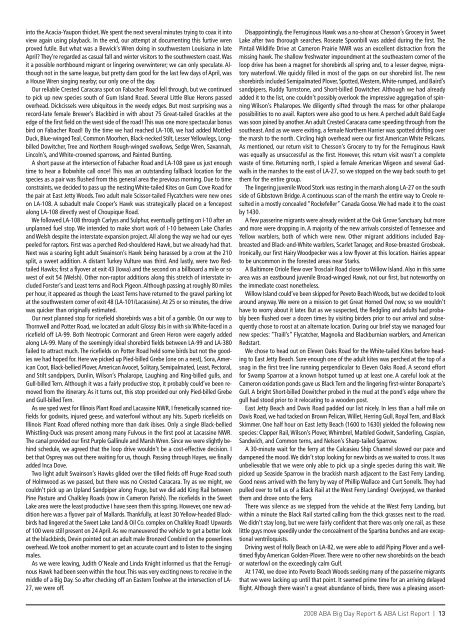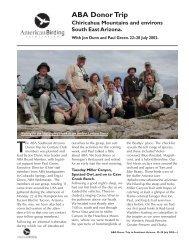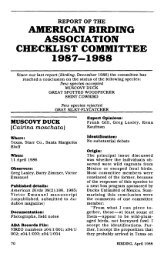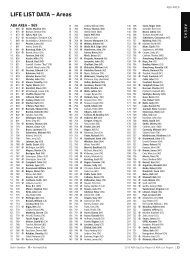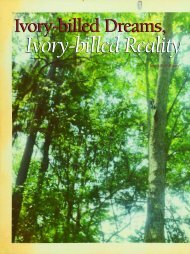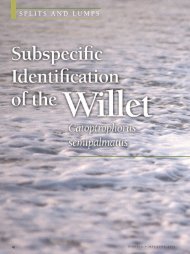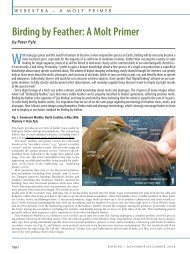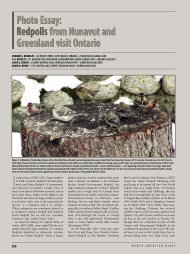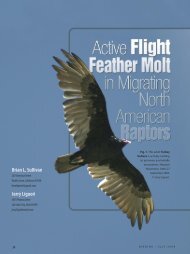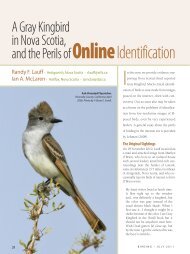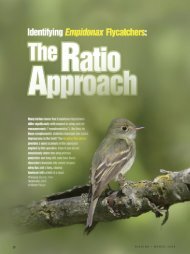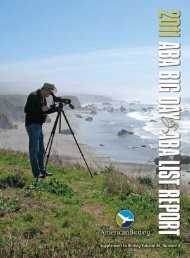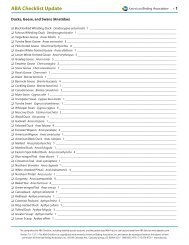Front End - American Birding Association
Front End - American Birding Association
Front End - American Birding Association
You also want an ePaper? Increase the reach of your titles
YUMPU automatically turns print PDFs into web optimized ePapers that Google loves.
into the Acacia-Yaupon thicket.We spent the next several minutes trying to coax it into<br />
view again using playback. In the end, our attempt at documenting this furtive wren<br />
proved futile. But what was a Bewick’s Wren doing in southwestern Louisiana in late<br />
April? They’re regarded as casual fall and winter visitors to the southwestern coast.Was<br />
it a possible northbound migrant or lingering overwinterer; we can only speculate. Although<br />
not in the same league, but pretty darn good for the last few days of April, was<br />
a House Wren singing nearby; our only one of the day.<br />
Our reliable Crested Caracara spot on Fabacher Road fell through, but we continued<br />
to pick up new species south of Gum Island Road. Several Little Blue Herons passed<br />
overhead. Dickcissels were ubiquitous in the weedy edges. But most surprising was a<br />
record-late female Brewer’s Blackbird in with about 75 Great-tailed Grackles at the<br />
edge of the first field on the west side of the road! This was one more spectacular bonus<br />
bird on Fabacher Road! By the time we had reached LA-108, we had added Mottled<br />
Duck, Blue-winged Teal, Common Moorhen, Black-necked Stilt, Lesser Yellowlegs, Longbilled<br />
Dowitcher, Tree and Northern Rough-winged swallows, Sedge Wren, Savannah,<br />
Lincoln’s, and White-crowned sparrows, and Painted Bunting.<br />
A short pause at the intersection of Fabacher Road and LA-108 gave us just enough<br />
time to hear a Bobwhite call once! This was an outstanding fallback location for the<br />
species as a pair was flushed from this general area the previous morning. Due to time<br />
constraints, we decided to pass up the nesting White-tailed Kites on Gum Cove Road for<br />
the pair at East Jetty Woods. Two adult male Scissor-tailed Flycatchers were new ones<br />
on LA-108. A subadult male Cooper’s Hawk was strategically placed on a fencepost<br />
along LA-108 directly west of Choupique Road.<br />
We followed LA-108 through Carlyss and Sulphur, eventually getting on I-10 after an<br />
unplanned fuel stop. We intended to make short work of I-10 between Lake Charles<br />
and Welsh despite the interstate expansion project. All along the way we had our eyes<br />
peeled for raptors. First was a perched Red-shouldered Hawk, but we already had that.<br />
Next was a soaring light adult Swainson’s Hawk being harassed by a crow at the 210<br />
split, a sweet addition. A distant Turkey Vulture was third. And lastly, were two Redtailed<br />
Hawks; first a flyover at exit 43 (Iowa) and the second on a billboard a mile or so<br />
west of exit 54 (Welsh). Other non-raptor additions along this stretch of interstate included<br />
Forster’s and Least terns and Rock Pigeon.Although passing at roughly 80 miles<br />
per hour, it appeared as though the Least Terns have returned to the gravel parking lot<br />
at the southwestern corner of exit 48 (LA-101/Lacassine).At 25 or so minutes, the drive<br />
was quicker than originally estimated.<br />
Our next planned stop for ricefield shorebirds was a bit of a gamble. On our way to<br />
Thornwell and Potter Road, we located an adult Glossy Ibis in with six White-faced in a<br />
ricefield off LA-99. Both Neotropic Cormorant and Green Heron were eagerly added<br />
along LA-99. Many of the seemingly ideal shorebird fields between LA-99 and LA-380<br />
failed to attract much. The ricefields on Potter Road held some birds but not the goodies<br />
we had hoped for. Here we picked up Pied-billed Grebe (one on a nest), Sora, <strong>American</strong><br />
Coot, Black-bellied Plover,<strong>American</strong> Avocet, Solitary, Semipalmated, Least, Pectoral,<br />
and Stilt sandpipers, Dunlin, Wilson’s Phalarope, Laughing and Ring-billed gulls, and<br />
Gull-billed Tern. Although it was a fairly productive stop, it probably could’ve been removed<br />
from the itinerary. As it turns out, this stop provided our only Pied-billed Grebe<br />
and Gull-billed Tern.<br />
As we sped west for Illinois Plant Road and Lacassine NWR, I frenetically scanned ricefields<br />
for godwits, injured geese, and waterfowl without any hits. Superb ricefields on<br />
Illinois Plant Road offered nothing more than dark ibises. Only a single Black-bellied<br />
Whistling-Duck was present among many Fulvous in the first pool at Lacassine NWR.<br />
The canal provided our first Purple Gallinule and Marsh Wren. Since we were slightly behind<br />
schedule, we agreed that the loop drive wouldn’t be a cost-effective decision. I<br />
bet that Osprey was out there waiting for us, though. Passing through Hayes, we finally<br />
added Inca Dove.<br />
Two light adult Swainson’s Hawks glided over the tilled fields off Fruge Road south<br />
of Holmwood as we passed, but there was no Crested Caracara. Try as we might, we<br />
couldn’t pick up an Upland Sandpiper along Fruge, but we did add King Rail between<br />
Pine Pasture and Chalkley Roads (now in Cameron Parish). The ricefields in the Sweet<br />
Lake area were the least productive I have seen them this spring. However, one new addition<br />
here was a flyover pair of Mallards. Thankfully, at least 30 Yellow-headed Blackbirds<br />
had lingered at the Sweet Lake Land & Oil Co. complex on Chalkley Road! Upwards<br />
of 100 were still present on 24 April.As we maneuvered the vehicle to get a better look<br />
at the blackbirds, Devin pointed out an adult male Bronzed Cowbird on the powerlines<br />
overhead.We took another moment to get an accurate count and to listen to the singing<br />
males.<br />
As we were leaving, Judith O’Neale and Linda Knight informed us that the Ferruginous<br />
Hawk had been seen within the hour.This was very exciting news to receive in the<br />
middle of a Big Day. So after checking off an Eastern Towhee at the intersection of LA-<br />
27, we were off.<br />
Disappointingly, the Ferruginous Hawk was a no-show at Chesson’s Grocery in Sweet<br />
Lake after two thorough searches. Roseate Spoonbill was added during the first. The<br />
Pintail Wildlife Drive at Cameron Prairie NWR was an excellent distraction from the<br />
missing hawk. The shallow freshwater impoundment at the southeastern corner of the<br />
loop drive has been a magnet for shorebirds all spring and, to a lesser degree, migratory<br />
waterfowl. We quickly filled in most of the gaps on our shorebird list. The new<br />
shorebirds included Semipalmated Plover, Spotted,Western,White-rumped, and Baird’s<br />
sandpipers, Ruddy Turnstone, and Short-billed Dowitcher. Although we had already<br />
added it to the list, one couldn’t possibly overlook the impressive aggregation of spinning<br />
Wilson’s Phalaropes. We diligently sifted through the mass for other phalarope<br />
possibilities to no avail. Raptors were also good to us here. A perched adult Bald Eagle<br />
was soon joined by another.An adult Crested Caracara came speeding through from the<br />
southeast.And as we were exiting, a female Northern Harrier was spotted drifting over<br />
the marsh to the north. Circling high overhead were our first <strong>American</strong> White Pelicans.<br />
As mentioned, our return visit to Chesson’s Grocery to try for the Ferruginous Hawk<br />
was equally as unsuccessful as the first. However, this return visit wasn’t a complete<br />
waste of time. Returning north, I spied a female <strong>American</strong> Wigeon and several Gadwalls<br />
in the marshes to the east of LA-27, so we stopped on the way back south to get<br />
them for the entire group.<br />
The lingering juvenile Wood Stork was resting in the marsh along LA-27 on the south<br />
side of Gibbstown Bridge. A continuous scan of the marsh the entire way to Creole resulted<br />
in a mostly concealed “Rockefeller” Canada Goose. We had made it to the coast<br />
by 1430.<br />
A few passerine migrants were already evident at the Oak Grove Sanctuary, but more<br />
and more were dropping in. A majority of the new arrivals consisted of Tennessee and<br />
Yellow warblers, both of which were new. Other migrant additions included Baybreasted<br />
and Black-and-White warblers, Scarlet Tanager, and Rose-breasted Grosbeak.<br />
Ironically, our first Hairy Woodpecker was a low flyover at this location. Hairies appear<br />
to be uncommon in the forested areas near Starks.<br />
A Baltimore Oriole flew over Trosclair Road closer to Willow Island. Also in this same<br />
area was an eastbound juvenile Broad-winged Hawk, not our first, but noteworthy on<br />
the immediate coast nonetheless.<br />
Willow Island could’ve been skipped for Peveto Beach Woods, but we decided to look<br />
around anyway. We were on a mission to get Great Horned Owl now, so we wouldn’t<br />
have to worry about it later. But as we suspected, the fledgling and adults had probably<br />
been flushed over a dozen times by visiting birders prior to our arrival and subsequently<br />
chose to roost at an alternate location. During our brief stay we managed four<br />
new species: “Traill’s” Flycatcher, Magnolia and Blackburnian warblers, and <strong>American</strong><br />
Redstart.<br />
We chose to head out on Eleven Oaks Road for the White-tailed Kites before heading<br />
to East Jetty Beach. Sure enough one of the adult kites was perched at the top of a<br />
snag in the first tree line running perpendicular to Eleven Oaks Road. A second effort<br />
for Swamp Sparrow at a known hotspot turned up at least one. A careful look at the<br />
Cameron oxidation ponds gave us Black Tern and the lingering first-winter Bonaparte’s<br />
Gull. A bright Short-billed Dowitcher probed in the mud at the pond’s edge where the<br />
gull had stood prior to it relocating to a wooden post.<br />
East Jetty Beach and Davis Road padded our list nicely. In less than a half mile on<br />
Davis Road, we had tacked on Brown Pelican,Willet, Herring Gull, Royal Tern, and Black<br />
Skimmer. One half hour on East Jetty Beach (1600 to 1630) yielded the following new<br />
species: Clapper Rail, Wilson’s Plover, Whimbrel, Marbled Godwit, Sanderling, Caspian,<br />
Sandwich, and Common terns, and Nelson’s Sharp-tailed Sparrow.<br />
A 30-minute wait for the ferry at the Calcasieu Ship Channel slowed our pace and<br />
dampened the mood.We didn’t stop looking for new birds as we waited to cross. It was<br />
unbelievable that we were only able to pick up a single species during this wait. We<br />
picked up Seaside Sparrow in the brackish marsh adjacent to the East Ferry Landing.<br />
Good news arrived with the ferry by way of Phillip Wallace and Curt Sorrells. They had<br />
pulled over to tell us of a Black Rail at the West Ferry Landing! Overjoyed, we thanked<br />
them and drove onto the ferry.<br />
There was silence as we stepped from the vehicle at the West Ferry Landing, but<br />
within a minute the Black Rail started calling from the thick grasses next to the road.<br />
We didn’t stay long, but we were fairly confident that there was only one rail, as these<br />
little guys move speedily under the concealment of the Spartina bunches and are exceptional<br />
ventriloquists.<br />
Driving west of Holly Beach on LA-82, we were able to add Piping Plover and a welltimed<br />
flyby <strong>American</strong> Golden-Plover. There were no other new shorebirds on the beach<br />
or waterfowl on the exceedingly calm Gulf.<br />
At 1740, we dove into Peveto Beach Woods seeking many of the passerine migrants<br />
that we were lacking up until that point. It seemed prime time for an arriving delayed<br />
flight. Although there wasn’t a great abundance of birds, there was a pleasing assort-<br />
2008 ABA Big Day Report & ABA List Report | 13


